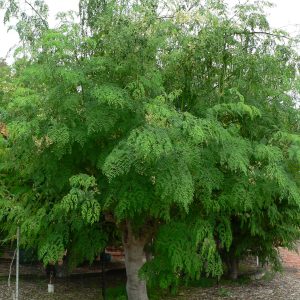Moringa oleifera
Moringa, drumstick tree, ben oil tree
Origin
Native to the foothills of the Himalayas but now grown pantropically. It has been cultivated in India for millennia.
Climate
It grows in dry sub-tropical and moist tropical areas up to 1500m, with precipitation of 450-2500mm pa. It can tolerate drought, however growth will be compromised. Although frost may denude the plant, it will quickly regrow if the frost is not prolonged.
Plant Description
A small fast-growing soft-wooded deciduous to evergreen tree depending on climate, 8-10m tall, with drooping branches. Leaves are alternate compound tripinnate, dark green on top and pale green underneath. The opposite leaflets are imparipinnate and 1-2cm long.
Relatives
Moringaceae family. There is only one genus in this family, with 14 species that occur across Asia and Africa.
Soils
Preference is for a slightly acid and well-drained clay loam but it can withstand pH 4.5-8.5.
Propagation
This is normally by seeds and cuttings, but budding is also successful. In localities where there are multiple plants, seedling-grown trees can be highly variable due to extensive out-crossing. In India, cuttings 1-2m long and up to 4cm diameter are commonly used, which strike easily.
Cultivars
There are several named cultivars overseas but these are very rarely seen in WA – most plants available locally will be seedlings of unknown parentage.
Flowering and Pollination
Inflorescences are long axillary drooping panicles. The individual bisexual flowers borne on 12mm long pedicels are fragrant, white or creamy-white and 2.5cm in diameter. Each has 5 green sepals, 5 creamy white petals, 5 stamens, 5 staminodes, and a 1-celled ovary and style. The flowering is dichogamous, favouring cross-pollination; with multiple plants about 25% are self-pollinated. Pollination is by bees and other insects, which are strongly attracted to the flowers.
Cultivation
All parts of the plants have uses, but in WA these would mainly be for the foliage and pods. It is often grown as an annual purely for the leaves and never allowed to be taller than 1m before being harvested. With trees grown for pods and leaves, NPK fertilization has been reported to increase yield up to threefold. It responds well to mulching.
Wind Tolerance
With its soft wood, it will be extensively damaged by strong winds and hail.
Pruning
It should be coppiced every year in late autumn, whereafter it will rapidly regrow to 4-5m tall each season. Such major pruning will facilitate harvesting, enhance its ability to withstand strong winds and also promote branching and increased pod production.
The Fruit
The pendulous three-lobed brown pods can be 30-120cm long, with a slight constriction between seeds. Pods are green when young and become increasingly fibrous and brown-coloured as they mature. There are 15-30 dark brown winged seeds in the pith.
Moringa has been called ‘The Tree of Life’, as pods and leaves are so nutritious. Leaves contain 9% high quality protein, 8% carbohydrate, very high levels of Ca, Fe and Mg, vitamin A and C and also reasonable thiamine and riboflavin. The pods are similarly nutritious.
Fruit Production and Harvesting
Seedling-grown trees can bear within 9-12 months and those from cuttings in half this time. They are short-lived, with yield declining after 10-15years. In warmer climates they can bear year round. Well-managed trees can produce more than 300 pods pa.
Fruit Uses
Young green pods that are easily snapped can be cooked like beans in vegetable dishes; they taste like asparagus. Pods may have internal strings running down the ribs; these can be removed by peeling the pods with a vegetable peeler. Leaves can be used in salads and cooked like spinach or put into curries, soups, sauces and pickles, but take care not to over-cook to preserve vitamin content. They can also be dried for later use. The flowers are edible when cooked and are said to taste like mushrooms.
Pests and Diseases
No major problems.
Comments
This a hardy and fast-growing plant that can thrive in our climate, with prolific production of pods and leaves. It will give you your own essentially permanent supply of a spinach-like vegetable. Attention to fertilisation will result in even better yields. You’ll have to prune annually. Bees come from everywhere to work the flowers.

